
Purpose-built mixed multihull
This article follows on from part 1 yesterday
NACRA pitched up in Santander last week at the ISAF Evaluation Trials for the Women’s mixed multihull slot for Rio 2016 with two offerings, one the Nacra 17 the only one of the multihulls to be purpose-designed and built for the trials.
The company has gone through a transformation in the last few years. Set up in 1975, NACRA, originally an acronym for the North American Catamaran Racing Association, for many years was owned by American keelboat manufacturer Catalina. However in 2007 NACRA was taken over by Gunnar Larsen and Peter Vink from the Netherlands, who’s company now owns the rights to the brand, the factory and distribution to their 84 dealers around the world. Larsen runs the sales and marketing effort globally while Vink focuses on the technical side out of their base in Den Haag in the Netherlands. They have since been dismantling the US operation with parts for their 11 boat range manufactured in different corners of the world – with composite components coming from Thailand, deck gear from Harken in the USA, carbon masts from France, etc.
Gunnar Larsen (left) with Peter Vink and their pride and joy...
“We don’t have to put the boats together any more like six or seven years ago, because we know it fits, because it is all ISO 92001 certified,” says Larsen. “Everything is to the drawings.”
NACRA’s range today is split between their ‘fun’ models used by schools, families and youth sails, such as the 460,500, 570 and 580, although these come with a ‘sports’ option including a jib and spinnaker kit. But of greater interest to thedailysail’s readership are their racing models, including their F16, their Mk2 F18, the Infusion, F20 Carbon plus the new Nacra 17, conceived especially for their Olympic bid.
Both the 16 and 17 are new. The F16 was launched the week before ISAF came out with their criteria (see yesterday’s article) for the Olympic mixed catamaran while the purpose-built 17 was kept under wraps until February.
With Formula 18 and Formula 16 classes dominant in the catamaran world, 17 is an unusual length although it is in fact 17.4ft long. “Our intention with the 17 is to tick as many boxes as possible,” says Larsen of how they put together the new boat to the ISAF spec. Although the boat is just shorter than an F18 it weighs some 40kg less than the 180kg minimum weight allowed under the F18 class rules.
Personally Larsen says he is enthusiastic about a mixed multihull making it into the Games. “There are more mixed crews coming into F18, that is quite tough if you are untrained, but elite athletes like my girlfriend [Lisa Westerhof], double World Championship in the 470 who going to the London 2012 - she is fit and she is able to sail a F18 with me at full noise. Getting an open mixed multihull into the Olympic Games is really good because then the girls from the 470 and from the skiffs can integrate into multihulls which brings multihulls and ISAF closer together, because for so long multihulls and ISAF were clashing.”
In fact Larsen and Westerhoff are pretty much the ISAF ideal – Larsen weighs 74kg, Westerhoff 61kg, so with a combined crew weight of 135kg they are spot on.
As with all of NACRA’s performance catamaran range, the 17 was designed by Gino Morrelli and Pete Melvin in the USA who are currently engaged leading the AC72 design effort at Emirates Team New Zealand.
So what is special about the 17? The boat has relatively low volume slightly rounded plumb bows with a lot of rocker, the aim being to reduce weight and windage, while allowing the boat to cut through waves before the volume kicks in half way back towards the forward crossbeam.
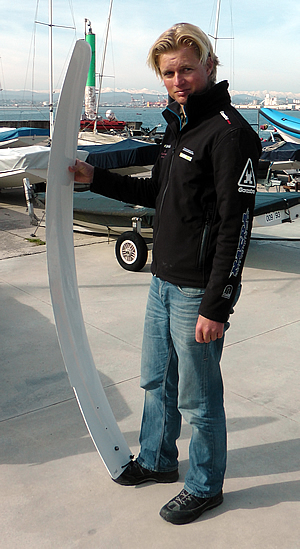 But the stand-out feature is that she was the only boat at the trials to feature the latest genre of curved daggerboards. Morrelli and Melvin have experience of these both from their AC design work, but also with Nacra on their 20 footer on which they also feature.
But the stand-out feature is that she was the only boat at the trials to feature the latest genre of curved daggerboards. Morrelli and Melvin have experience of these both from their AC design work, but also with Nacra on their 20 footer on which they also feature.
This type of daggerboard, which have been popularised in the dinghy world on F20s and A-Cats following their use on ORMA 60 trimarans and on the 33rd America’s Cup multihulls, obviously have the dual function of preventing leeway while also adding lift (more so as the cat flies a hull). Larsen argues that the curved boards also help widen weight range in which crews can be competitive.
Vink says that they discussed using some even more cutting edge technology such as the L-shaped foils that Oracle Racing has been caught testing on one of their AC45s, however he says that these have to be fitted from beneath and they discounted the idea.
Larsen also points out that they talked with ISAF about in the new catamaran's mixed crew whether it was important that man or woman could perform either role, rather than the norm of having the woman helming and the man carrying out the grunty work in the crew spot, as is typically the case in the F18 class. With this in mind, Larsen says they have set up the 17 (ie sheet loads, etc) so that either crew can easily perform either role.
The NACRA 17 is made from glass and epoxy with a foam core, although carbon fibre is used for local reinforcement in loaded areas like the beams supporting the daggerboards and the stringers in the bows. Carbon is also used in the foils and the two part mast – although NACRA also had an alloy mast fitted on one of their 17s, the alloy option weighing some 6kg more.
Construction of the boards is interesting as they are made in a heavyweight moulds and after the two shells are laminated they are fitted into this tool with the stringers, the tool clamped together and the cavity filled with expanding epoxy foam fed inside via a small pipe. “Normal foam gives a pressure of 80 or 120psi. But this goes to 300... You let the foam kick off and then you close it. It is a technique they use on big blades to make them in carbon but it is not too heavy and still they can still take the sheer loads,” says Vink.
Sail controls are the norm for a cat of this type with a 16:1 purchase on the Cunningham. As Vink says: “On cats the load is higher on the Cunningham than it is on the main sheet, to control mast bending, the depth of the sail, etc.” They also have the controls on the mast spanner set up so that the upwind mast rotation setting is retained, useful for getting up to speed quickly out of the leeward mark.
The diamonds are controlled via a bolt on the bottom of the mast, which can be adjusted while out on the water to ease the diamond tension and the prebend of the mast. The jib is a self-tacker and there is a device on the clew to alter the sheeting position. There is a snuffer system for the kite which is drawn down through a hoop on the port side of the mast - again all standard performance catamaran features.
A nice feature of the 17 is that the trampoline is fitted with ‘kick bars’, effectively foam pads built into the trampoline to provide a foothold when not out on the wire but also to provide something with which the crew can help to kick themselves out on to the wire.
In terms of sails, Larsen and Vink also own Performance Sails which supplies their catamaran range, which they feel will be another feather in their cap in terms of their possible Olympic prospects.
Also in Santander was NACRA’s smaller F16 which according to Larsen was there mainly because it too ticks all of the boxes in the specification ISAF has a laid down. This Larsen describes the 16 as being somewhere between a beginner’s boat and one of their full-on racing cats.
The significant differences between the F16 and the purpose-built 17 is that the boards are straight, although they are toed in by 6° – the maximum allowed under class rules. “When you sail with more angle you feel that they generate some lift, not as much as the 17,” says Vink. However the boards are also made in carbon epoxy. Otherwise the 16 has slightly less carbon fibre reinforcement in it.
As with the Viper featured yesterday, NACRA has chosen not to go down to the F16’s minimum weight of 108kg. “We could make it 20kg lighter, which is a hell of a lot,” says Vink. “But we have a stiff platform so that when a puff hits, our boats reacts, while theirs is flexing all the time. AHBC chose that path too [with the Viper]. They made their boat 130kg and we are doing the same because then you make a reliable strong stiff boat.”
Since launching the F16 in September, NACRA has already sold 60 of them with hull #18 shortly to be delivered. “The biggest market is not the racing people it is dad with a friend or kids,” says Vink. “We are getting feedback from dealers at boat shows that they are getting new people on their stands. And that is good – that is exactly what we need.”
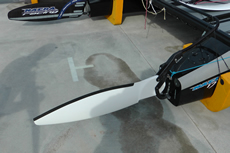 |
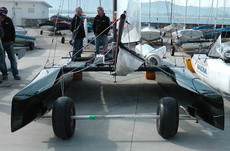 |
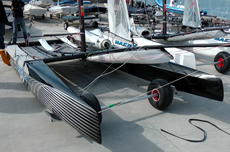 |
 |
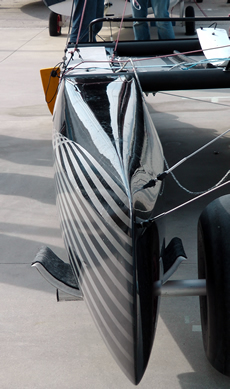 |
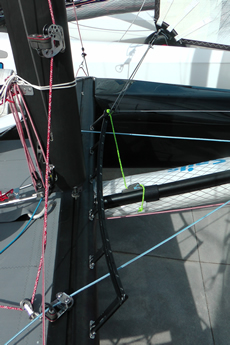 |
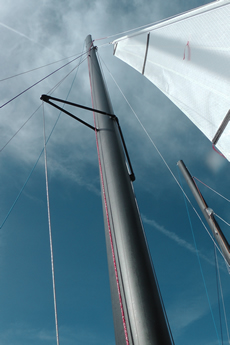 |
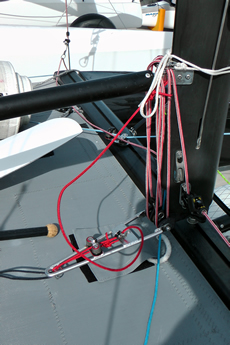 |
 |
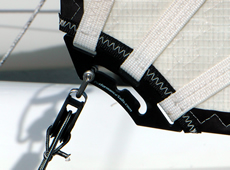 |
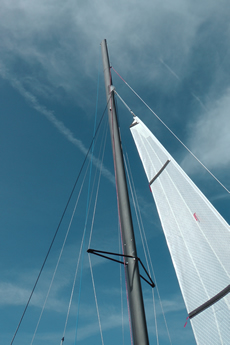 |
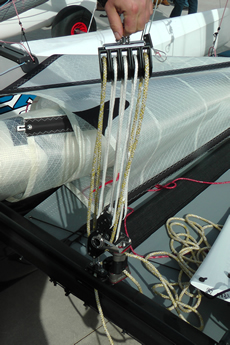 |
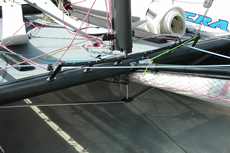 |
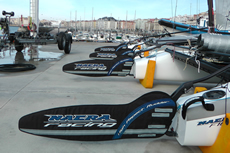 |
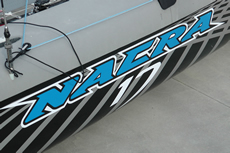 |

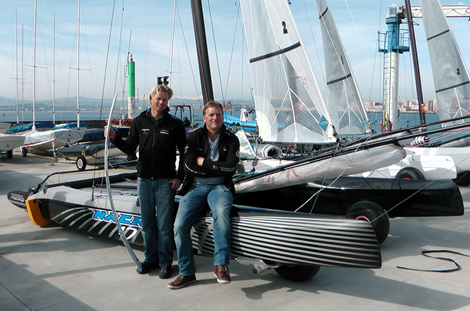
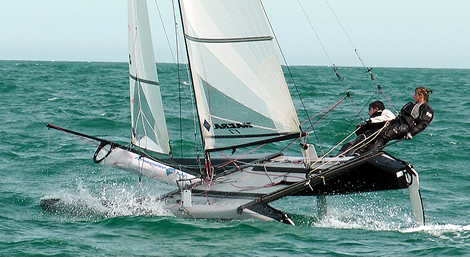
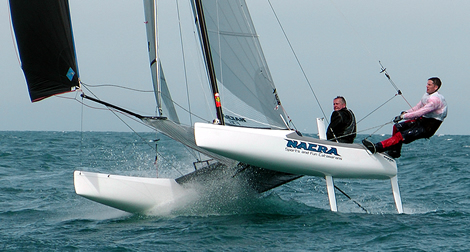







Latest Comments
Add a comment - Members log in